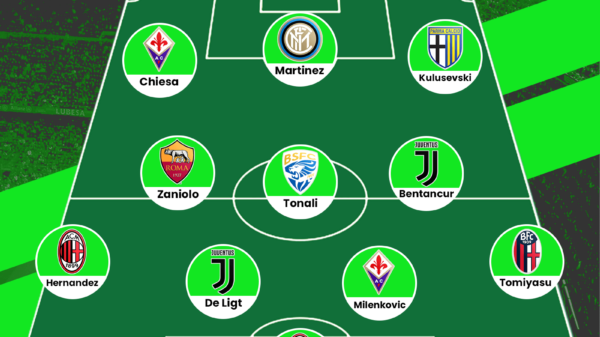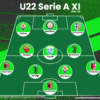Matt Gunn writes a detailed tactical analysis about the Serie A match that ended Roma 1-0 AC Milan.
You’d be forgiven for thinking that Monday night’s matchup between Serie A giants Roma and AC Milan was going to be the game of the season so far. The Stadio Olimpico played host to what promised to be a tantalizing affair between 2nd and 3rd place, both tied on points and both desperate to keep up with Juventus at the top of the table.
Despite Milan’s impressive form heading into the game; one loss in their last twelve games in all competitions; their inexperience on the field without veteran Montolivo showed as they struggled to hold onto the ball and maintain pressure for any extended period of time. Roma, on the other hand, entered the game as clear favourites, having won all eight of their home league games this season – a feat matched only by leaders Juventus. Though “I Giallorossi” did play midweek in Europe, their early qualification meant that Luciano Spalletti could rotate his squad effectively ahead of a fierce matchup against their northern rivals.
Despite the vast array of world-class talent on show, Monday’s matchup was devoid of any real individual or technical brilliance – aside from Nainggolan’s goal, of course. Roma set their sights on goal from kick-off, hoping that an early goal would allow them to take the edge off the game and put them in a position to control the match. However, Milan set the tone for the game by inviting pressure and sticking to their defensive shape. This made for a tense affair which resembled more of a game of chess, rather than a clash for 2nd place.
Line Ups:

Made using TacticalPad
Roma: Sczcesny; 2. Rudiger, 44. Manolas, 20. Fazio, 33. Emerson; 16. De Rossi, 6. Strootman; 13. Peres, 4. Nainggolan, 8. Perroti; 9. Dzeko.
AC Milan: 99. Donnarumma; 20. Abate, 29. Palletta, 13. Romagnoli, 2. De Sciglio; 80. Pasalic, 73. Locatelli, 91. Bertolacci; 8. Suso, 9. Lapadula, 11. Niang.
Roma lined up in a compact 4-2-3-1 formation, which shifted towards a 4-2-2-2 when in defence in order to break down Milan’s build-up play. The towering Edin Dzeko bossed Milan’s defensive third, hassling defenders and creating space with intelligent runs into the channels. Nainggolan sat just behind in an unfamiliar yet strangely comfortable attacking midfield role – his tenacity and box-to-box-style tendencies were key to Roma’s attacking and defensive plays. Peres impressed with the ball at his feet while filling in for the injured Mohammed Salah on the right wing, while Diego Perotti struggled to influence the game from the left. Ever-reliable Daniele De Rossi and Kevin Strootman dictated the game from the centre of the field, with the former uncharacteristically leaving his defence open at times in order to join the disjointed Roma attack. Emerson attacked down the left wing from a full back position and often found himself inside Milan’s area but lacked a substantial final ball.
Milan’s front three of Niang, Lapadula and Suso were remarkably quiet on the night, with the former seeming to drop off the face of the earth after missing a penalty in the 26th minute. An inexperienced trio of Bertolacci, Locatelli and Pasalic struggled under Roma’s pressure in the centre, though their late runs into the area to join a rare Milan attack were impeccable, with each taking it in turns to assist the front three. This meant that they became increasingly difficult for Strootman and De Rossi to track from deep. Their defensive efforts were impressive given their average age of 22. They remained disciplined and protected their back four with great success, stifling any opportunities in the centre of the pitch. De Sciglio and captain Abate got forward on the break, but refrained from attacking often as not to leave themselves open at the back.
Mossa, mossa!
Roma lacked any flow in their attack, though they moved the ball well, instead of maintaining pressure on Milan’s stout defensive wall they rushed and looked to get the ball wide in order to stretch Milan and free up Dzeko for a header inside the area. On occasion, due to the law of averages, it worked; Edin Dzeko’s willingness to attack the ball in the air negated Milan’s numerical advantage on the ground and allowed him the occasional free header in the area.
In terms of creating chances, however, Roma’s best opportunities came from intelligent runs from wide players towards the centre and vice versa, with Nainggolan as the primary pivot. Bruno Peres often carried the ball across the field as an impromptu inverted winger creating space behind him for Strootman/Nainggolan to drift into. His movement with the ball disrupted Milan’s excellent defensive setup and allowed Roma space in the final third to pick their opponents apart. Coupled with Edin Dzeko’s clever runs between the now-occupied fullback and centre back, a simple pass back towards the wing meant that Roma’s key playmaker was (usually) on the ball, with his striker in a position to run behind the now-disorganized defence. Failing that, Dzeko’s immense dynamism meant that he could sit in front of the defence and hold up the ball – something of a masterclass in the 2nd half, by the way. Due to the open space where Nainggolan was, holding the ball up allowed Strootman and De Rossi to take up more advanced positions and throw yet even more numbers into the attack.

While Roma committed men to the attack, Milan did the opposite. Their discipline and defensive shape allowed them to soak up pressure and hit Roma on the break with the pace of Niang and Suso down the wings. The benefit of three central midfielders was that Milan would still have outlet players should Roma defend the wide areas. Without a traditional number nine in the line up, Milan could not capitalise on the incredible amount of space Roma had conceded in the centre of the pitch by pushing De Rossi and Strootman forward. Lapadula’s hold up play was almost non-existent as “I Rossoneri” struggled to keep the ball in Roma’s half and apply any amount of sustained pressure for large periods of the game.
That’s not to say that Milan didn’t have their own chances, and they did move the ball well throughout the game. Suso and Niang looked to play off the shoulder of the fullbacks, stretching the defensive line and allowing space for Bertolacci, Pasalic and Locatelli to run into. They played to their strengths; any crosses were from deep and in swinging, causing problems for Szczesny and his two centre backs.
Intelli-Press

The key to Roma’s performance was their pressure between Milan’s defensive third and the transitional third in the centre of the field. Nainggolan made the jump from CM to CAM earlier this season and it’s easy to see why – he was without doubt Roma’s best player on the night. Although he’s being deployed in a new position, he maintains all the characteristics which made him a world-class box-to-box midfielder. Nainggolan’s ability to read the game is second to none, pair that with his tenacity and immense stamina and you have the perfect pressing machine.
Pressing hasn’t quite reached Italian football just yet. In a league lauded for its defensive culture, teams much prefer to have the ball in front of them, and know all too well the consequences of leaving themselves open to attack. Better to be safe than sorry, right? Roma pressed effectively against Milan, but with the aim of keeping the ball as far away from their goal as possible, as opposed to the “Gegenpress” we’ve become so accustomed to in European football.
Roma kept Milan facing their own goal. Their high midfield line meant that their zonal marking scheme almost became a man-mark across the centre of the pitch. Dzeko worked his way across Milan’s backline, hassling defenders into making rash decisions. Behind him, Nainggolan gnawed away at the heels of Bertolacci while Strootman and De Rossi kept close tabs on Pasalic and Locatelli. This meant that, although Milan had the ball, they simply had nowhere to go. Niang and Suso were occupied out wide, and Lapadula’s lack of hold up play meant that Milan had nothing to aim for in the centre of the field. Perotti and Peres aided Nainggolan in his task by keeping both fullbacks at bay and covering the central midfielders if they attempted to drift wide. Milan ran out of options and had the majority of their possession between their own and the central thirds of the pitch.
Conclusion
As a game touted as the biggest of the season so far, it most definitely did disappoint. Though, given what was at stake, you can forgive both teams for their cautious attacking styles.
Roma struggled to find any kind of rhythm throughout the game and often rushed their attacking moves in the hope of catching Milan sleeping. Milan left much to be desired going forward. Though they’re in good form, they’re not quite at the level they once were, and their status as overachievers shone through against Roma, they simply weren’t good enough.
Read all our tactical analyses here.
- Tactical Analysis: AS Roma 1-0 AC Milan | Chess match settled by Nainggolan - December 16, 2016
- Tactical Analysis: Athletic Bilbao 3-2 Sassuolo | Good, old fashioned wing play the flavour of the day - December 1, 2016
- Tactical Analysis: England 2-2 Spain | Start of a transition for both teams - November 18, 2016


























































